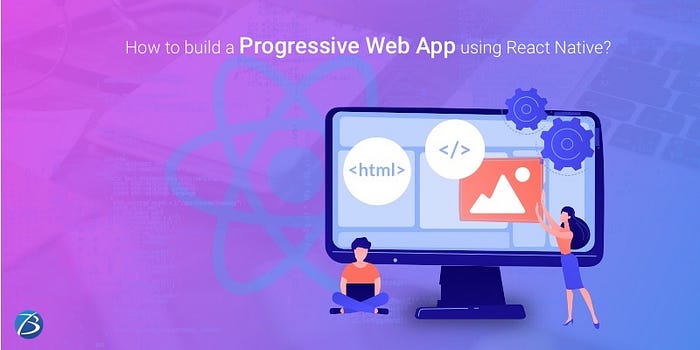Guidance on how to develop a Progressive Web App using React Native!


A Progressive Web Application (PWA) is a disruptive innovation that integrates the functionality of a native mobile app and the usability of a responsive website. Several business brands have harnessed the goodies of progressive web apps to reach unprecedented heights of success.
Take a look at the success stories of the following brands on account of PWA adoption, as published by the online research portal “Cloud Four”.
- ‘Flipkart’ experienced a 40% increase in the re-engagement rate.
- ‘5miles’ was able to reduce the bounce rate by 50% and boost the conversion rate by 30%.
- With their new PWA, ‘Tinder’s’ load times decreased from 11.91 sec to 4.69 sec and also, the engagement rate shot up. Besides, the PWA is 90% smaller as compared to their native Android app.
- Twitter’ witnessed a 65% spike in the pages per session, a 75% increase in Tweets, and a 20% decrease in the bounce rate.
- ‘Forbes’ experienced a 43% increase in the sessions per user, a 20% boost in the ad viewability, and a 100% spike in the engagement rate.
Thus, it is evident that progressive web app development is successfully fulfilling the demanding user expectations and challenging business requirements of modern times.
So, if you too are one of those planning to build a PWA, the obvious question that will crop up in your mind is, “Which framework is best suited for PWA development?” Many, businesses and corporates prefer React Native for end-to-end PWA development and hire efficient React Native developers for the same.
This blog guides you through crafting a PWA using the React Native Framework. But before we commence, let me enlighten you on some crucial facts about PWAs and the reasons to choose React Native Development.
Progressive Web App (PWA): Unique Strengths
The usual websites can be conveniently accessed from any device or browser, but they fail to leverage the platform-specific hardware that ensures high performance. Native apps, on the other hand, can completely utilize the platform-specific hardware and software capacities to optimize performance but are available only for the particular platform for which they are designed. But, progressive web applications combine the best of both worlds and are known for delivering a native app-like experience in the browser. The distinct capabilities of this futuristic software solution are as follows.
- Delivers a native-like experience.
- Loads instantly and promptly respond to user inputs.
- Integrates push notifications for maximizing user engagement.
- Offers a highly responsive UI and consistent UX across mobile phones, tablets, and PCs.
- Integrates with users’ devices and utilizes the device capabilities to the fullest for delivering improved performance.
- Employs cached data from earlier interactions to provide offline access to content and certain features.
- Are easily discoverable and can be installed by simply clicking a pop-up without having to visit the app store.
- Possesses cross-platform compatibility and involves a cost-efficient developmental cycle.
- Is reliable and secure.
- Takes up less storage memory.
Why choose React Native Development for PWA Creation?
React Native is considered to be an apt progressive web app development framework as it proves immensely advantageous for developers. Let’s peek into the reasons:
- It is a JavaScript library containing multiple in-built packages and ready-to-use plugins.
- The ‘create-react-app’package helps in configuring the app with ready-to-use features. This speeds up development and makes it possible to create a PWA in real-time.
- The SW-Precache-Webpack-plugin enables the creation of highly functional PWAs decked up with rich features. Besides, the fact that this plugin is integrated with create-react-app, eases out things further.
Thus, if a PWA is built using React Native, the end-product becomes more progressive with lesser efforts.
Key Steps on Creating a PWA with React Native
Check out the key requirements for PWA creation.

Adoption of a Secure Network Connection
Adopting a secure network connection for PWA creation ensures security and helps you to gain users’ trust. Sometime back, the Google team had declared HTTP web pages as not safe and secure and had advised going for an HTTPS connections that is more secure. So, it is essential that mobile app companies opt for HTTPS connection while developing PWA. For using HTTPS, one can employ service workers, thus, activating home screen installations.
Implementing the “Add to Home Screen” Option
After you serve the web on HTTPS, do not forget to implement the “Add to Home Screen” option for your users. This move is sure to improve the user experience and as such, expedite the conversion rate for your brand. To execute this task you need to add a Web App Manifest or manifest.json file to the PWA.
Employing Web App Manifest
Adding the manifest.json file to the app’s root directory allows the users to install the app on their smartphones effortlessly. It should contain details such as name, icons, description as well as a splash screen for the application. The manifest.json file can either be written by your React Native Developers or created employing a tool. This file consists of metadata in a public folder that controls the app’s visual appearance on the home screen of users.
So, given below are key terms used while coding manifest.json. (Let’s assume that your app’s name is Dizon)
- Short_name: The name of the app (Dizon) is displayed when you add it to the users’ home screen.
- Name: Browser uses this name when users add the application to their home screen. It is displayed as “Add Dizon to Home Screen.”
- Icons: The icon of your app is visible on the users’ home screens.
- Start_url: It is the URL that specifies the starting point of the PWA.
- Theme_color: It regulates the toolbar color of the users’ browsers.
- Background color: When the app is launched, the background color of the splash screen can be changed.
- Display: This feature enables one to tweak the browser view and you may run the app on a separate window or a full screen.
Implementing Custom Splash Screen
Whenever users launch a PWA on their Android devices, a white screen is displayed till the app is ready for use. This white blank screen is visible for a longer time, hence implementing a custom splash screen is important to get a better user experience. A Custom splash screen enables you to employ an icon displaying your brand and a custom background for the PWA, imparting a native-like look and feel.
Usage of Pusher to add Real-time Functionalities
A React Native App Development Company should employ Pusher to add Real-time functionalities in their PWA. This is so because Pusher simplifies the task of binding the UI interactions to the events which are triggered by the server or the client. The setup process involves:
- Logging in to the dashboard and building a new app
- Copying the app_id, secret, key, cluster and then store these for future usage.
- Setting up a server in node.js which will assist in triggering events using Pusher.
- Creating a file called ‘server.js’ in the project’s root directory with the required content. Further details can be viewed in this linked content by Pusher
Integrating a Service Worker
A PWA development company needs to integrate a service worker — a script running in the background that does not interact with the actual app. Its function is to regulate installations, push notifications, caching, etc. Service Workers play a vital role by intercepting the network requests in the background and caching information to facilitate offline usage.
Auditing the Code with Lighthouse
Auditing the code with Google’s automated open-source tool called Lighthouse will help in monitoring the performance of a web application. This tool runs multiple tests for examining the performance, accessibility, etc. of a web app and generates a report for the same. These reports prove useful in fixing the weak aspects of the PWA like performance, best practices, accessibility, etc. Additionally, the Lighthouse plugin guides on resolving the issues and thus, improving performance.
Final Verdict:
React Progressive Web Apps help businesses across diverse domains establish their digital footprints successfully. In today’s smartphone-dominated world, PWAs have become an absolute necessity for businesses to gain loyal and happy customers. Therefore, if you are planning to develop a web app or a website, it is advisable to deploy the same as a PWA as it adds convenience to the users and hence improves the user engagement and experience. For any technical assistance on PWA development reach out to Biz4Solutions, a distinguished React Native app development company offering incredible web/mobile app development services for clients across the globe.
I hope this blog was beneficial.
Do share your opinions and experiences on PWAs in the comments section.
To know more about our other core technologies, refer to links below:
Other articles and publications:
Articles and publications of other companies:
- +1 (469) 277-0804
- 8305 Tripoli Trl, Frisco, TX 75034, United States
- www.biz4solutions.com/










